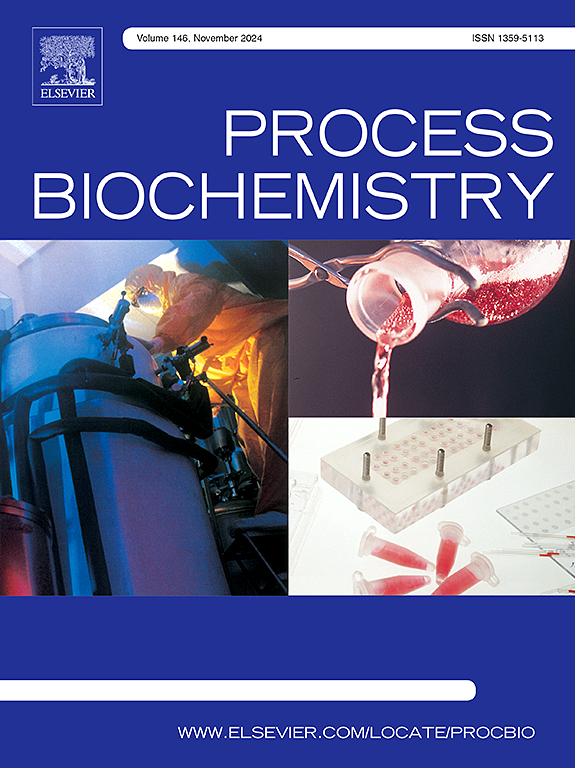普鲁兰小孢子菌合成培养基增强2-苯乙醇及协同生产普鲁兰
IF 3.7
3区 生物学
Q2 BIOCHEMISTRY & MOLECULAR BIOLOGY
引用次数: 0
摘要
2-苯乙醇(2-PE)及其衍生物在食品调味和精细化工合成中起着至关重要的作用。然而,它们的工业规模生产产量仍然是广泛工业应用的关键制约因素。为了克服这一挑战,我们采用了一种集成的原位产物吸附(ISPR)策略,结合氮源限制和高糖培养基配方,在2-PE生物合成过程中使用普鲁兰Aureobasidium pullulans (a . pullulans) A5。值得注意的是,这种方法可以同时联合生产2-PE和具有商业价值的胞外多糖普鲁兰。实验方案包括两个阶段:首先,我们建立了含有20 % (w/v)葡萄糖和1.8 % (w/v)酵母氮基(YNB)的基础生产培养基(medium-1)。随后,我们系统筛选了吸附剂,确定三烷基膦氧化物(TRPO)为最佳萃取剂,具有选择性2-PE吸附能力,但对l -苯丙氨酸(L-phe)没有吸附能力。在优化的体系中,在50 mL培养基(pH 6.0)中添加10 mL TRPO,并添加4 g/L L-phe作为前体,发酵48 h后,2-PE产量为2.39 g/L(摩尔转化效率为60% %),普鲁兰积累量为5.16 g/L。工艺分析显示,trpo介导的ISPR提高了2-PE的体积效率,而高碳介质配置协同提高了两种目标代谢物的滴度。这些技术改进大大提高了过程经济性,同时简化了工业规模操作的下游处理本文章由计算机程序翻译,如有差异,请以英文原文为准。
Enhanced 2-phenylethanol and co-production of pullulan from synthetic medium by Aureobasidium pullulans
2-phenylethanol (2-PE) and its derivatives play crucial roles in food flavoring and fine chemical synthesis. However, their industrial-scale production yields remain a key constraint for broader industrial implementation. To overcome this challenge, we implemented an integrated in-situ product adsorption (ISPR) strategy combined with nitrogen source restriction and a high-glucose medium formulation during 2-PE biosynthesis using Aureobasidium pullulans (A. pullulans) A5. Notably, this approach enabled simultaneous co-production of 2-PE and the commercially valuable exopolysaccharide pullulan. The experimental protocol comprised two phases: First, we established a basal production medium (medium-1) containing 20 % (w/v) glucose and 1.8 % (w/v) Yeast Nitrogen Base (YNB). Subsequently, we systematically screened adsorption agents, identifying Trialkylphosphine Oxide (TRPO) as an optimal extractant that demonstrated selective 2-PE adsorption capacity but not for L-phenylalanine (L-phe). In the optimized system, supplementation of 10 mL TRPO to 50 mL medium-1 (pH 6.0) supplemented with 4 g/L of L-phe as precursor resulted in 2.39 g/L 2-PE production (60 % molar conversion efficiency) and 5.16 g/L pullulan accumulation after 48 h fermentation. Process analysis revealed that TRPO-mediated ISPR enhanced 2-PE volumetric productivity, while the high-carbon medium configuration synergistically increased both target metabolite titers. These technical improvements significantly improved process economics while simultaneously streamlining downstream processing for industrial-scale operations
求助全文
通过发布文献求助,成功后即可免费获取论文全文。
去求助
来源期刊

Process Biochemistry
生物-工程:化工
CiteScore
8.30
自引率
4.50%
发文量
374
审稿时长
53 days
期刊介绍:
Process Biochemistry is an application-orientated research journal devoted to reporting advances with originality and novelty, in the science and technology of the processes involving bioactive molecules and living organisms. These processes concern the production of useful metabolites or materials, or the removal of toxic compounds using tools and methods of current biology and engineering. Its main areas of interest include novel bioprocesses and enabling technologies (such as nanobiotechnology, tissue engineering, directed evolution, metabolic engineering, systems biology, and synthetic biology) applicable in food (nutraceutical), healthcare (medical, pharmaceutical, cosmetic), energy (biofuels), environmental, and biorefinery industries and their underlying biological and engineering principles.
 求助内容:
求助内容: 应助结果提醒方式:
应助结果提醒方式:


